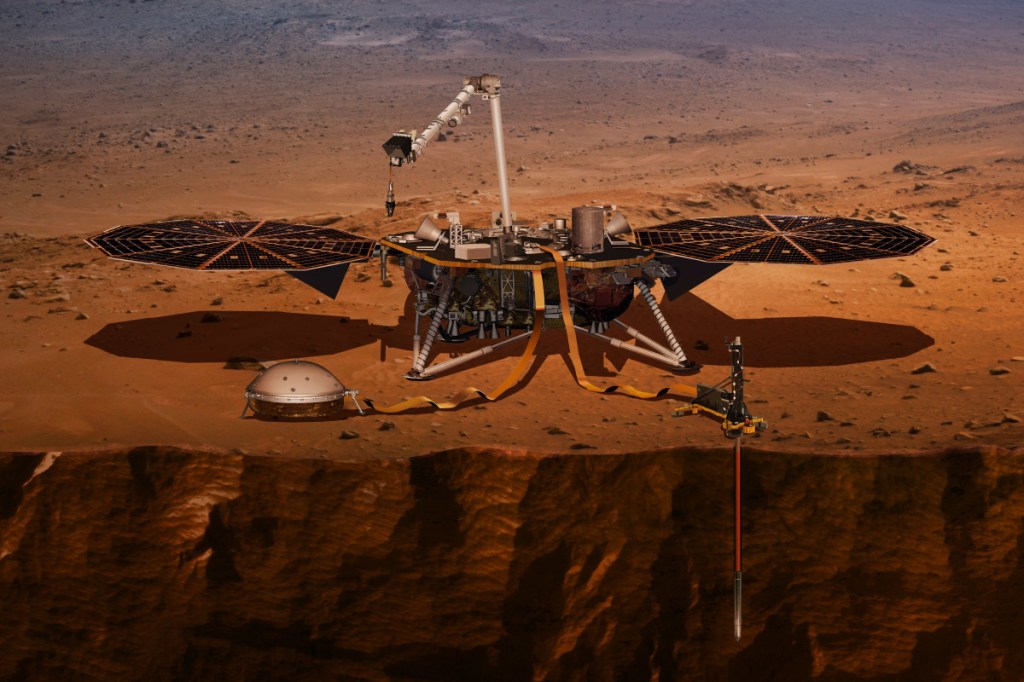For decades, earthlings have dispatched spacecraft to Mars to study the planet’s dusty surface and its thin atmosphere. Now NASA is sending a lander to the red planet to look deep into its heart.
As early as Saturday morning, NASA’s InSight will blast off from Vandenberg Air Force Base in California. After a nearly seven-month journey, it will begin probing the deep interior of a nearby world that once may have looked much more like our own.
The Interior Exploration using Seismic Investigations, Geodesy and Heat Transport mission aims to understand the hidden heat flow of the planet, its seismic activity and the nature of its core. All of these could help scientists delve into the history and evolution of our planetary neighbor.
“Even though we’ve had a lot of missions to Mars – orbiters and also landers and rovers crawling around on the surface – we’ve never had a mission that was devoted to looking inside Mars,” said Gerald Schubert, a geophysicist and planetary physicist at UCLA who is not involved in the mission. “InSight’s really unique in exploring the internal structure and composition of the terrestrial planets. There’s never really been one like this before.”
NASA has sent seismometers to Mars before, aboard the two Viking landers that touched down in 1976. But those didn’t work as planned – the instrument on Viking 1 failed, and the one on Viking 2 was overwhelmed by vibrations from the Martian winds. The last time NASA seismometers were successfully deployed off Earth was during the Apollo missions to the moon.
Bruce Banerdt remembers those Viking failures all too well. A graduate student in geological sciences at the time, he felt a pang of dismay when it became clear the sensors wouldn’t produce much, if any, seismological data.
Now Banerdt is a geophysicist at the Jet Propulsion Laboratory in La Canada Flintridge and the principal investigator for InSight. With a new generation of Martian seismometers ready for launch, “I can hardly even sleep at night, I’m so excited,” he said. “It’s been such a long path.”
Rovers, landers and orbiting spacecraft have found evidence of lakes, rivers, volcanoes and life-friendly chemical combinations on Mars. Seismology allows scientists to glimpse the internal machinations that led to those features.
“With seismology, we can basically put together a 3D map of the inside of the planet,” Banerdt said. “From that we can start to understand how the planet was formed, how it works.”
Billions of years ago, scientists think, Mars looked much more like Earth: It had water lakes and perhaps even a shallow ocean under puffy clouds that floated in a thick atmosphere. Tests conducted by the Curiosity rover have shown that microbial life could theoretically have existed in an environment such as this.
Then the planet’s interior cooled and Mars lost most of its atmosphere. Without it, the water evaporated and the surface became the rusty, dusty expanse we see today.
Studying Mars’ internal dynamics will help scientists learn why it evolved the way it did, Banerdt said.
For example, Earth has a protective magnetic field that prevents our atmosphere from being stripped away by the solar wind and cosmic rays. That field is powered by the movement of molten metal in Earth’s core.
Mars appears to have lost its magnetic shield early in its history, and the planet’s atmosphere today is about 100 times thinner than Earth’s. Studying the Martian core could help researchers understand why Mars’ fate diverged from our own.
On a rocky planet like Mars, the heat that comes from the core is produced by radioactive elements, said Sue Smrekar, a JPL geophysicist and InSight’s deputy principal investigator. That heat would have powered Martian volcanoes and other geophysical reactions, ultimately producing the planet’s atmosphere and at least some of its liquid water.
Knowing things like where the atmosphere came from, what was in it and how long it lasted could help scientists estimate how long Mars hosted life-friendly environments. And knowing the concentrations of radiogenic elements inside Mars will help scientists figure out how much energy was available to fuel all of this activity, Smrekar said.
“That helps us better understand the original building blocks of the planet,” she said.
Once InSight lands on Mars in late November, it will act as a solar-paneled doctor, using its three main instruments to take the planet’s temperature, check its reflexes and perform a sonogram.
The craft will place a seismometer on the surface of the planet and then cover it with a protective shield to damp out the wind and thermal “noise” on the surface. This seismometer will listen for marsquakes – the Martian version of earthquakes – as well as meteorite strikes.
Both produce seismic waves that are altered in different ways as they pass through the planet’s layers of material. The farther away these perturbations originate the better, because the waves will pass through more material before reaching the seismometer. Studying the subtle modifications to those waves will reveal a clearer picture of the planet’s contents.
Copy the Story LinkSend questions/comments to the editors.



Success. Please wait for the page to reload. If the page does not reload within 5 seconds, please refresh the page.
Enter your email and password to access comments.
Hi, to comment on stories you must . This profile is in addition to your subscription and website login.
Already have a commenting profile? .
Invalid username/password.
Please check your email to confirm and complete your registration.
Only subscribers are eligible to post comments. Please subscribe or login first for digital access. Here’s why.
Use the form below to reset your password. When you've submitted your account email, we will send an email with a reset code.